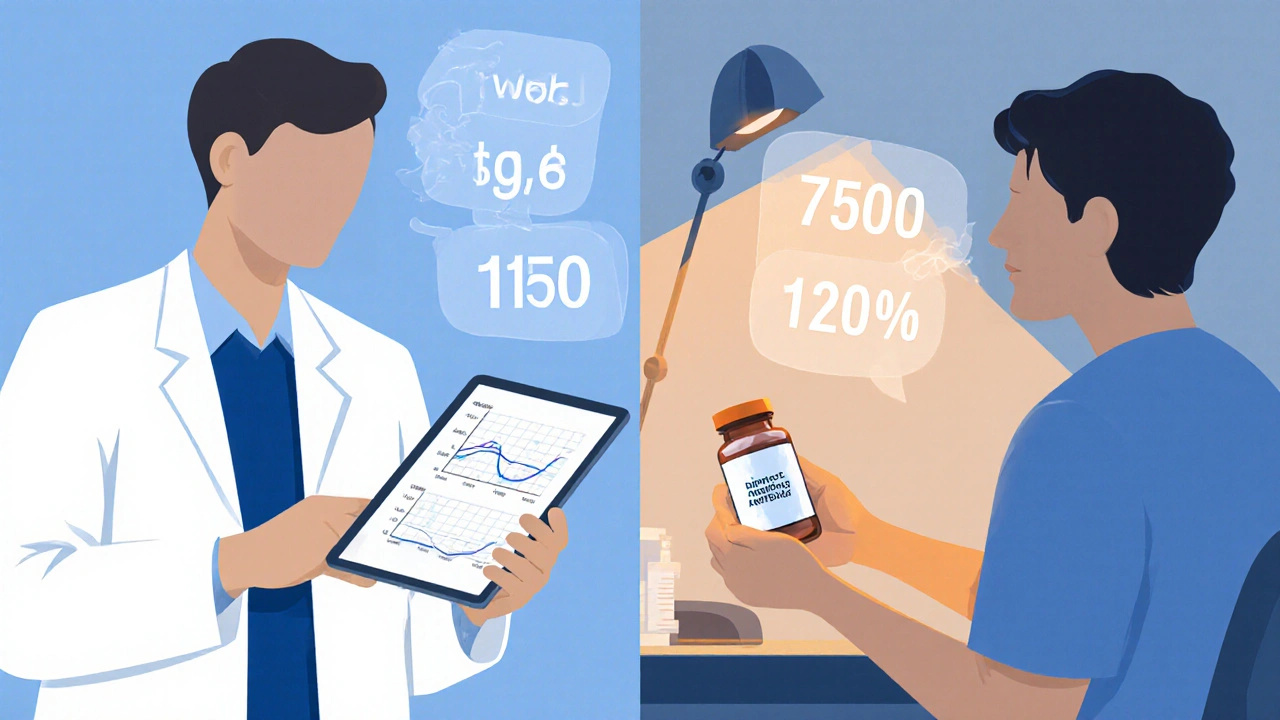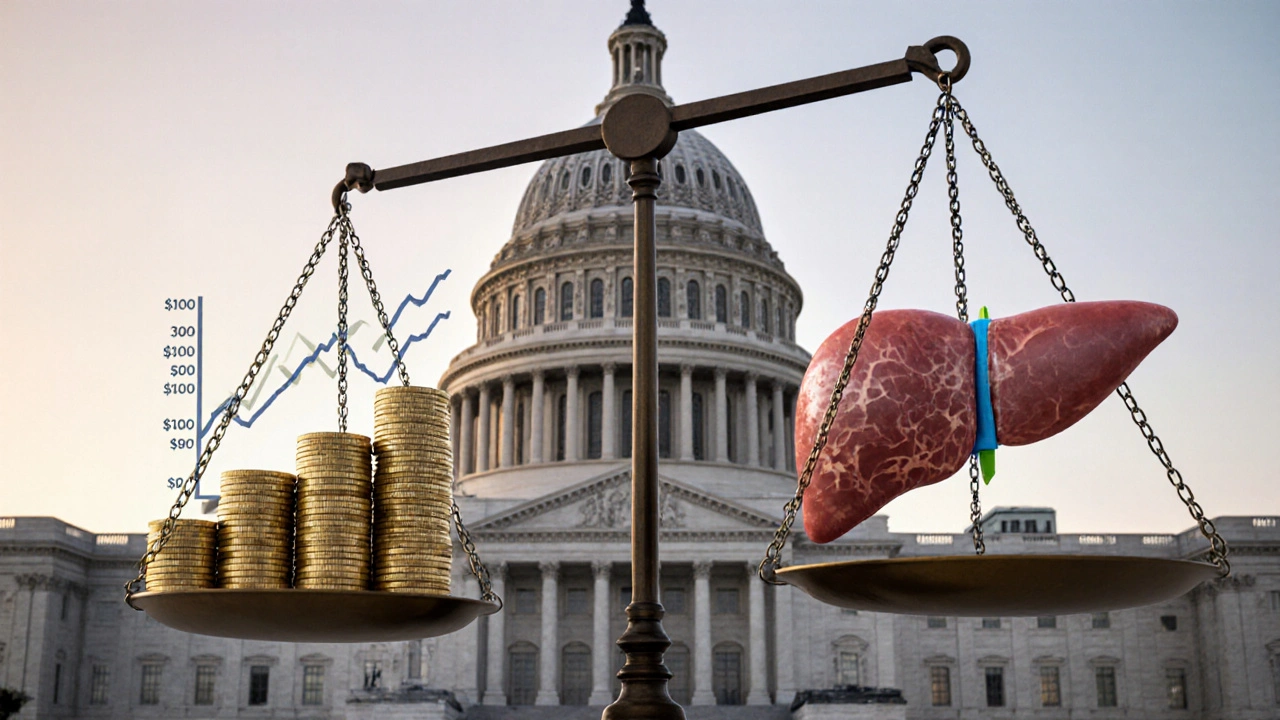
Chronic Hepatitis C Cost Estimator
Estimated Annual Costs
Key Insights
This estimate is based on average New Zealand costs for chronic hepatitis C patients. Actual costs may vary depending on individual circumstances and treatment response.
Early treatment with DAAs can reduce long-term costs by up to 70%. Government subsidies typically cover 70-80% of DAA costs.
Key Takeaways
- Direct medical expenses for chronic hepatitis C in NewZealand average NZ$7,500 per year per patient.
- Lost productivity and disability can add another NZ$4,000-NZ$8,000 annually.
- Early treatment with direct‑acting antivirals reduces long‑term costs by up to 70%.
- Government subsidies, private insurance, and patient assistance programs can offset up to 60% of out‑of‑pocket costs.
- Understanding the full economic picture helps patients and policymakers make smarter decisions.
What Is Chronic Hepatitis C and Why It Matters financially
When we talk about Chronic Hepatitis C is a long‑lasting infection caused by the Hepatitis C virus (HCV) that can damage the liver over years, the health side is obvious. But the financial impact of chronic hepatitis C is just as real for patients, families, and health systems.
The virus spreads mainly through blood contact, and without a cure it can progress to cirrhosis, liver cancer, or the need for a transplant. Each stage brings new costs, both direct (medication, doctor visits) and indirect (missed work, reduced earning potential).
Direct Medical Costs: What You Pay for Care
Direct‑acting antivirals (DAA) are highly effective oral drugs that can clear HCV in 8-12 weeks for most patients. In NewZealand, a full DAA course ranges from NZ$12,000 to NZ$18,000, but government subsidies usually cover 70-80% for eligible patients.
Beyond medication, the following line items make up the bulk of medical spending:
- Specialist consultations (hepatology, infectious disease) - NZ$150-NZ$250 per visit.
- Laboratory monitoring (viral load, liver function) - NZ$80-NZ$120 per test.
- Imaging (ultrasound, elastography) - NZ$200-NZ$350 per study.
- Management of complications (e.g., cirrhosis, variceal bleeding) - NZ$3,000-NZ$10,000 per episode.
When a patient reaches end‑stage liver disease, a transplant can cost NZ$200,000-NZ$250,000, plus lifelong immunosuppressive therapy at roughly NZ$6,000 per year.

Indirect Costs: Lost Productivity and Insurance Premiums
Indirect expenses often outpace the drug bill. Chronic fatigue, abdominal pain, and frequent medical appointments can lead to missed work days.
Lost productivity refers to the value of work hours missed or performed at reduced efficiency due to illness is estimated at NZ$4,500 per patient annually in the Wellington region alone, according to a 2023 health‑economics study.
Insurance dynamics add another layer. Premiums can rise 5-10% for individuals with a diagnosed chronic condition, translating to an extra NZ$300-NZ$600 per year for a typical family policy.
Long‑Term Economic Burden: Cirrhosis, Cancer, and Transplant
If the virus isn’t cleared early, the risk of liver cirrhosis climbs to 20-30% after 20years. Cirrhosis brings:
- Regular monitoring - NZ$2,000 per year.
- Hospital admissions for decompensation - average NZ$8,000 per stay.
- Potential liver cancer treatment - NZ$50,000-NZ$80,000 over the disease course.
These figures often dwarf the one‑time DAA expense. A cost‑effectiveness analysis published by the NewZealand Ministry of Health in 2024 showed that treating every diagnosed patient with DAAs could save between NZ$1.2billion and NZ$1.7billion over a decade by preventing advanced disease.
Managing the Financial Load: Assistance Programs and Insurance Strategies
Several mechanisms help soften the blow:
- Government subsidies - The PHARMAC program funds up to 80% of DAA courses for residents meeting clinical criteria.
- Patient assistance programs - Pharmaceutical companies offer free or discounted medication for low‑income patients.
- Private health insurance - Plans that include “specialist cover” can reduce out‑of‑pocket specialist fees by 40%.
- Tax deductions - In NewZealand, medical expenses over NZ$1,000 are claimable as a tax credit.
Understanding eligibility thresholds is crucial. For example, the PHARMAC subsidy applies only if the patient’s viral load is above 10,000 IU/mL and they have not been treated for HCV in the past 12months.
Real‑World Numbers: A NewZealand Case Study
Meet Sarah, a 42‑year‑old accountant from Wellington diagnosed in 2019. Her financial journey illustrates typical cost patterns:
- Initial specialist consults and tests - NZ$1,200.
- DAA course (subsidized at 75%) - out‑of‑pocket NZ$3,000.
- Six months of missed work (2 weeks) - NZ$4,500 lost earnings.
- Follow‑up monitoring (year 1) - NZ$500.
Total first‑year cost for Sarah was roughly NZ$9,200, but avoided long‑term complications saved an estimated NZ$30,000‑NZ$50,000 over the next 10years.
Aggregate data from the NZ Ministry of Health’s 2024 HCV registry show an average annual cost per patient of NZ$7,800, with 58% of that attributed to direct medical care and 42% to indirect losses.

Policy Implications: Why the Numbers Matter to Decision‑Makers
Governments use cost analyses to shape funding priorities. The clear economic upside of early DAA treatment bolsters arguments for expanding screening programs, especially in high‑risk groups such as people who inject drugs.
Employer‑driven health benefits can also be tuned. Offering onsite HCV testing and covering DAA therapy can reduce absenteeism, improve productivity, and lower overall insurance premiums for the workforce.
Bottom Line: The True Cost of Living with Chronic Hepatitis C
Beyond the virus itself, the financial impact of chronic hepatitis C ripples through medical bills, work life, and even mental health. Early diagnosis, timely DAA therapy, and leveraging available subsidies dramatically cut both short‑term out‑of‑pocket spending and long‑term economic strain.
For patients, the key is to stay informed about financial assistance options and to discuss cost‑saving strategies with healthcare providers. For policymakers, the data make a strong case for broader screening and full subsidy coverage.
Comparison of Cost Components (2025 NZ Data)
| Cost Category | Average Annual Expense (NZ$) | Typical Funding Source |
|---|---|---|
| Direct‑acting antivirals (first‑year) | 7,500 | PHARMAC subsidy (≈75%) |
| Specialist & lab visits | 1,200 | Mixed (private + public) |
| Lost productivity | 4,500 | Employer/individual |
| Insurance premium uplift | 450 | Private insurer |
| Complication management (average) | 2,800 | Public health system |
| Total Average | 16,450 | - |
Frequently Asked Questions
How much does a full course of direct‑acting antivirals cost in NewZealand?
Without subsidies the price ranges from NZ$12,000 to NZ$18,000, but PHARMAC usually covers 70‑80% for eligible patients, leaving an out‑of‑pocket cost of roughly NZ$3,000-NZ$4,500.
Can I claim HCV‑related medical expenses on my taxes?
Yes. In NewZealand, medical costs exceeding NZ$1,000 in a tax year are eligible for a tax credit. Keep receipts for medication, specialist visits, and lab tests.
What assistance programs are available for low‑income patients?
Both the government’s PHARMAC subsidy and pharmaceutical‑company patient assistance programs can provide free or heavily discounted DAAs. Eligibility typically depends on income level and clinical need.
How does chronic hepatitis C affect my work life?
Patients often report fatigue and occasional pain, leading to missed workdays or reduced productivity. On average, NewZealand studies estimate a loss of NZ$4,500 per year per patient.
Is there a cost benefit to treating hepatitis C early?
Early DAA treatment can cut long‑term costs by up to 70% because it prevents expensive complications like cirrhosis, liver cancer, and transplantation.
Write a comment
Your email address will not be published.





18 Comments
The economic burden of chronic hepatitis C is not merely a medical statistic, it is a moral failing of our societies.
When patients are forced to choose between life‑saving medication and putting food on the table, we must ask what kind of world we are constructing.
The numbers presented in the article-NZ$7,500 for antivirals, NZ$4,500 in lost productivity-are not abstract figures but real hardships endured by families.
Moreover, the subsidy model, while helpful, still leaves a gap that disproportionately harms low‑income individuals.
It is a testament to policy shortsightedness that a disease which can be cured with an eight‑week regimen still carries a six‑figure shadow in indirect costs.
The systemic neglect is evident when we see insurance premiums creeping up by five to ten percent for those diagnosed.
This penalty punishes the victim twice, first with illness and then with financial strain.
The ethical imperative is clear: governments must fully fund the entire course of direct‑acting antivirals.
Partial subsidies create a false sense of progress while maintaining barriers that keep many out of treatment.
The article’s suggestion that early treatment reduces long‑term costs by 70 percent should be a rallying cry for universal coverage.
Let us not romanticize the idea of “personal responsibility” when the system itself erects the obstacles.
Health equity demands that we eliminate out‑of‑pocket expenses, regardless of income bracket.
The moral calculus here outweighs any budgetary hesitation; lives saved are priceless.
In addition, employers stand to benefit from reduced absenteeism, a fact that should incentivize private sector support.
If we truly care about the well‑being of our citizens, the conversation must shift from cost‑containment to cost‑elimination.
Anything less is a betrayal of the social contract we owe to each other.
Yo, think about it – chronic Hep C is like that hidden boss in a video game you keep dodging, but the real boss is the wallet drain.
We’re talking meds that could cost a small house, and then you lose gigs ‘cause you’re tired.
It’s absurd that we have to gamble with health when the system basically says, “pay up or get sick.”
Early treatment is the cheat code, but only if the game lets you use it without paying extra fees.
Bottom line: stop letting money be the final level you can’t beat.
i think its really helpful lol
While the emotional narrative is compelling, reducing the entire issue to a mere “pay‑up or get sick” cliché oversimplifies a complex health economics landscape and overlooks the nuanced policy decisions that shape subsidy structures.
Ah, the drama of dollars and disease! Imagine a world where the only thing scarier than the virus itself is the looming invoice that follows every lab test, every specialist visit, every sleepless night.
It’s a theatrical tragedy, and we, the audience, are forced to pay for the tickets.
Esteemed members of this discourse, permit me to articulate a measured contemplation upon the fiscal ramifications elucidated herein.
The data presented, whilst ostensibly comprehensive, invite a deeper philosophical inquiry into the equitable distribution of healthcare resources.
One might posit that the very existence of such a financial burden constitutes an ethical paradox demanding rectification.
I hear your concern and acknowledge the moral weight of these figures; it is indeed a collective responsibility to alleviate such burdens where feasible.
From a systemic perspective, the cost‑effectiveness ratio of direct‑acting antivirals versus long‑term morbidity indicators illustrates a clear deviation from optimal health economics.
Implementing full‑scale coverage aligns with both macro‑budgetary efficiency and micro‑patient outcome optimization.
Indeed, while the jargon-laden exposition is accurate, one must also consider the ethical imperative that transcends mere cost‑benefit matrices; the sanctity of human life should not be reduced to an equation.
In reviewing the presented financial analysis, it is evident that the current subsidy framework is insufficient, thereby necessitating immediate legislative reform to ensure comprehensive coverage for all affected individuals.
Sure, because nothing says “good healthcare” like a spreadsheet of expenses that make you wonder if your doctor moonlights as a tax accountant.
Nice summary
Friends, let us remember that every statistic represents a human story; sharing knowledge empowers us all to support one another in navigating these challenges.
Wow!!! This is a total disaster!!! The government is totally failing!!! Patients are being ripped off!!! Immediate action needed!!!
While the outburst captures frustration, a balanced approach that acknowledges systemic constraints and seeks collaborative solutions would likely yield more constructive outcomes.
It is clear that early treatment not only saves lives but also reduces economic strain, a fact that should guide public health policies towards broader screening and access.
People keep preaching the same old narratives without addressing the deeper societal responsibilities that underpin health inequities.
Honestly, reading all these numbers makes me feel like I'm stuck in a never‑ending lecture about healthcare costs that never ends, and it's kinda boring but also kind of interesting because, you know, money matters and health matters, so I guess we should care about both, but the way they keep repeating the same points over and over again without giving any fresh perspective feels like a waste of time, and maybe if they added some real‑world stories or something it would be more engaging, but still, the data is solid and shows that early treatment is worth it, so maybe that's the main takeaway here, that we should push for better subsidies and make sure people don't have to choose between their health and their bills.